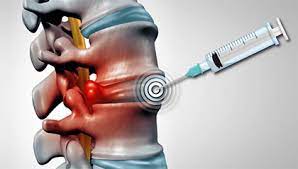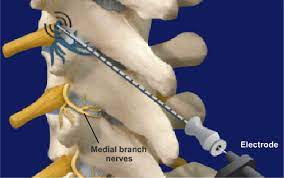
Sciatica is a common condition that affects the sciatic nerve, which is the largest nerve in the body. The sciatic nerve runs from the lower back down to the legs and feet, and when it becomes inflamed or compressed, it can cause pain, numbness, and tingling sensations.
Causes of sciatica.
- Herniated Disc: A herniated disc occurs when the soft tissue inside a disc in the spine bulges out, putting pressure on the surrounding nerves, including the sciatic nerve. This can cause pain, numbness, and tingling sensations in the lower back, hips, legs, and feet.
- Spinal Stenosis: Spinal stenosis occurs when the spinal canal narrows, putting pressure on the spinal cord and nerves, including the sciatic nerve. This can cause pain, numbness, and tingling sensations in the lower back, hips, legs, and feet.
- Piriformis Syndrome: Piriformis syndrome occurs when the piriformis muscle in the buttocks becomes tight or spasms, putting pressure on the sciatic nerve. This can cause pain, numbness, and tingling sensations in the buttocks, hips, legs, and feet.
- Degenerative Disc Disease: Degenerative disc disease occurs when the discs in the spine begin to wear down and lose their cushioning ability, putting pressure on the surrounding nerves, including the sciatic nerve. This can cause pain, numbness, and tingling sensations in the lower back, hips, legs, and feet.
- Spondylolisthesis: Spondylolisthesis occurs when a vertebra in the spine slips out of place and puts pressure on the surrounding nerves, including the sciatic nerve. This can cause pain, numbness, and tingling sensations in the lower back, hips, legs, and feet.
While many cases of sciatica can be treated with conservative measures such as physical therapy and pain medication, some cases require more advanced treatment.
Some modern methods for treating sciatica.

- Epidural Steroid Injections: Epidural steroid injections are a common treatment for sciatica. During this procedure, a steroid medication is injected into the epidural space near the affected nerve to reduce inflammation and relieve pain. This treatment is generally performed on an outpatient basis and can provide long-lasting relief from sciatica symptoms.
- Microdiscectomy: Microdiscectomy is a minimally invasive surgical procedure that is used to treat sciatica caused by a herniated disc. During this procedure, a small incision is made in the back and a small portion of the herniated disc is removed to relieve pressure on the affected nerve. Microdiscectomy is associated with a faster recovery time and less postoperative pain than traditional open surgery.

- Spinal Decompression Therapy: Spinal decompression therapy is a non-surgical treatment that uses a motorized traction device to stretch the spine and relieve pressure on the affected nerve. This treatment is performed in a physical therapy setting and can provide long-lasting relief from sciatica symptoms.

- Radiofrequency Ablation: Radiofrequency ablation is a minimally invasive procedure that uses heat to destroy the nerve fibers that are causing pain. This treatment is generally performed on an outpatient basis and can provide long-lasting relief from sciatica symptoms.

- Physical Therapy: Physical therapy is a conservative treatment for sciatica that involves exercises and stretches designed to improve flexibility and strength in the affected area. Physical therapy can also help to improve posture and reduce pressure on the affected nerve.
Many people also turn to home remedies to help relieve their symptoms. Some home remedies for sciatica.

- Stretching: Stretching is a simple and effective way to relieve the pain associated with sciatica. Gentle stretching exercises can help to relieve tension in the affected area and reduce pressure on the sciatic nerve. Some recommended stretches for sciatica include the seated spinal twist, the standing hamstring stretch, and the knee-to-chest stretch.

- Heat and Cold Therapy: Heat and cold therapy can help to reduce inflammation and relieve pain associated with sciatica. Applying a heating pad or hot water bottle to the affected area can help to increase blood flow and relax tight muscles, while applying an ice pack can help to reduce swelling and numbness.

- Massage: Massaging the affected area can help to relieve tension and reduce pain associated with sciatica. A gentle massage can help to increase blood flow and release tension in the muscles surrounding the sciatic nerve. You can use your hands or a foam roller to massage the affected area.

- Yoga: Yoga is a gentle and effective way to relieve sciatica pain. Certain yoga poses, such as the downward-facing dog and the pigeon pose, can help to stretch the muscles surrounding the sciatic nerve and reduce pressure on the nerve.

- Turmeric: Turmeric is a natural anti-inflammatory that can help to reduce inflammation and pain associated with sciatica. You can add turmeric to your food or take a turmeric supplement.

- Ginger: Ginger is another natural anti-inflammatory that can help to reduce inflammation and relieve pain associated with sciatica. You can add ginger to your food or drink ginger tea.

- Rest: Resting the affected area can help to reduce pain and inflammation associated with sciatica. Try to avoid activities that aggravate your symptoms and take breaks throughout the day to rest your back and legs.
In conclusion, while there are modern treatments available for sciatica, many people find relief from their symptoms through home remedies such as stretching, heat and cold therapy, massage, yoga, turmeric, ginger, and rest. If you experience symptoms of sciatica, such as pain, numbness, or tingling sensations in the lower back, hips, legs, or feet, you should see a doctor or a physical therapist for an accurate diagnosis and appropriate treatment.
